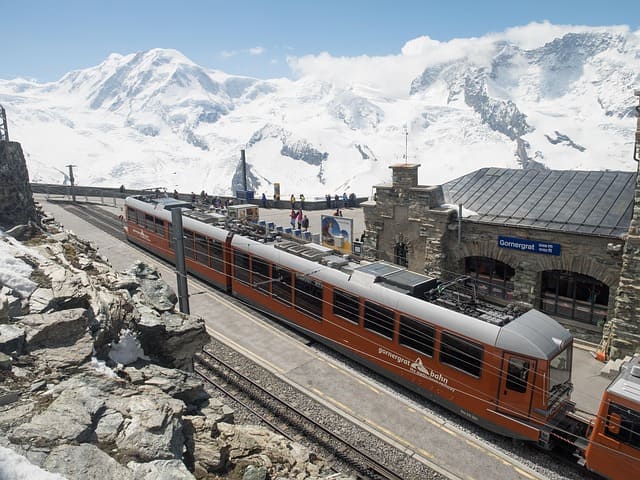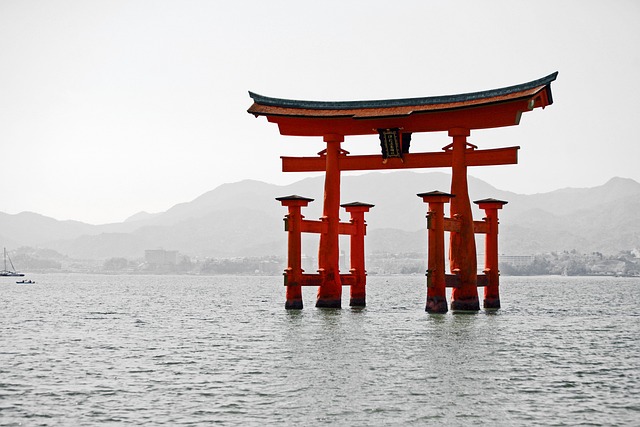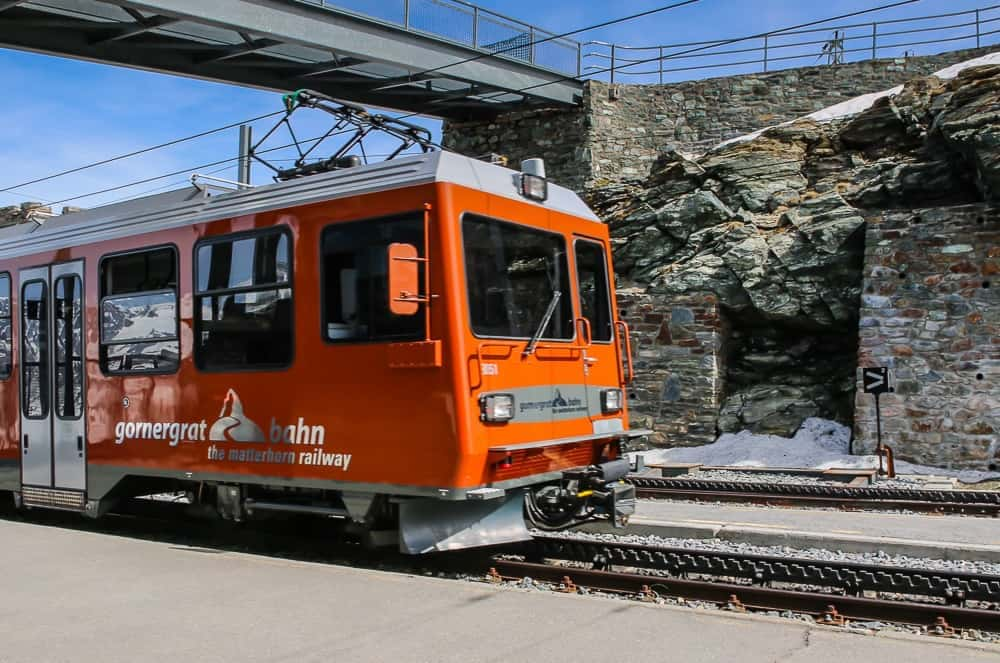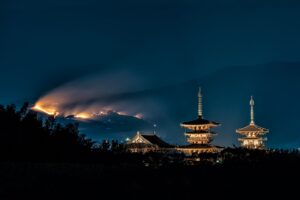Gornergrat

The Gornergrat is a stunning mountain ridge in the Swiss Alps, located near the resort town of Zermatt in the canton of Valais, Switzerland. It sits at an elevation of 3,089 meters (10,135 feet) and is famous for offering panoramic views of the Matterhorn and more than 20 peaks above 4,000 meters, including Monte Rosa, the highest mountain in Switzerland. Gornergrat Railway (Gornergratbahn) is the highest open-air cogwheel railway in Europe, it takes visitors from Zermatt up to the Gornergrat summit in about 33 minutes. The journey itself is spectacular, winding through alpine forests, rocky slopes, and offering increasingly breathtaking views. The journey gives one of the best places to view and photograph the Matterhorn, especially at sunrise or sunset. The unobstructed vista is a major draw for photographers and nature lovers.
Starting your day trip from Täsch, you can efficiently visit both the Matterhorn Glacier Paradise and Gornergrat in a single day. Here’s a detailed itinerary to help you make the most of your experience:
Morning: Täsch to Zermatt
Departure: Catch the Zermatt Shuttle Train from Täsch. Trains depart approximately every 15–20 minutes, starting as early as 05:55 AM. The journey takes about 12 minutes. Arrive at Zermatt Station, which is conveniently located near the departure points for both attractions.
Matterhorn Glacier Paradise (Morning)
From Zermatt, take the Matterhorn Express gondola to Trockener Steg, then transfer to the 3S cable car to reach the Matterhorn Glacier Paradise. Cable cars operate year-round, typically from 9:00 AM to 4:00 PM. You can reach the Matterhorn Glacier Paradise directly from Zermatt via a series of gondola and cable car rides—there is no train service to the summit. There are two main gondola routes to reach the summit at Klein Matterhorn (3,883 meters). (1) Direct Route (Faster): Zermatt → Furi: 7-minute gondola ride. Furi → Trockener Steg: 10-minute gondola ride. Trockener Steg → Matterhorn Glacier Paradise: 11-minute ride on the Matterhorn Glacier Ride, the highest 3S cableway in the world. This route is efficient and offers stunning views, especially on the final leg. Note that children under 3 years old are not permitted on the final segment due to altitude concerns . (2). Scenic Route via Schwarzsee (More Panoramic): Zermatt → Furi: 7-minute gondola ride. Furi → Schwarzsee: 8-minute gondola ride. Schwarzsee → Trockener Steg: 9-minute gondola ride. Trockener Steg → Matterhorn Glacier Paradise: 8-minute ride. This route allows for a stop at Schwarzsee, offering unique perspectives of the Matterhorn and opportunities for photography .
The journey is both scenic and efficient, taking approximately 40 to 45 minutes in total, depending on the route and transfer times. Explore the Glacier Palace. Enjoy panoramic views from the observation deck. Panoramic vistas of 38 Alpine peaks across Switzerland, Italy, and France. Visit the Cinema Lounge for informative films. Allocate approximately 2 hours for this visit. Operating hours may vary, so it’s advisable to check the latest schedule before your visit.
Gornergrat (Afternoon)
Visitors often take the cogwheel train (Europe’s highest open-air railway) from Zermatt to the summit. The ride itself offers breathtaking views. The cogwheel train is the highest open-air railway in Europe. The ride provides spectacular views of the Matterhorn, Gorner Glacier, and surrounding 4,000-meter peaks. Return to Zermatt and board the Gornergrat Railway from the station directly opposite the main train station. Enjoy the scenic cogwheel train ride to the summit. Take in the 360-degree panoramic views of the Alps. Visit the highest alpine garden in Europe and Riffelsee Lake. Spend about 1.5 to 2 hours at the summit. Trains run every 24 to 35 minutes, with the last descent varying by season.
Numerous trails start or end at Gornergrat, including easy panoramic walks and more challenging alpine hikes. You might see marmots, ibex, and other alpine animals, especially in the summer months. The “Five Lakes Walk” is a popular trail offering reflections of the Matterhorn in mountain lakes. The clear skies and high altitude make Gornergrat an excellent spot for stargazing. There’s even an astronomical observatory (Gornergrat South Observatory). There is a virtual paragliding experience available near Zermatt called “Zooom the Matterhorn”, located at the Gornergrat summit. This immersive attraction allows visitors to simulate a paragliding flight around the Matterhorn without leaving the ground. At “Zooom the Matterhorn,” you can embark on a simulated paragliding journey: Sit in specially designed chairs that mimic the sensation of flight. Wear virtual reality headsets that provide a 360° view of the alpine landscape. Use hand controls to steer your virtual paraglider, giving you the feeling of piloting through the skies. This experience offers breathtaking views of green meadows, rugged rocks, and majestic mountain ridges, culminating in a virtual circle around the Matterhorn’s summit cross at 4,478 meters above sea level.
The Kulmhotel Gornergrat, also known as the 3100 Kulmhotel Gornergrat, is the highest hotel in the Swiss Alps, situated at an elevation of 3,100 meters (10,170 feet) above sea level on the Gornergrat ridge near Zermatt, Switzerland. Established in 1910, it offers guests unparalleled panoramic views of iconic peaks such as the Matterhorn and Monte Rosa, as well as 29 other summits exceeding 4,000 meters. The hotel boasts 22 rooms, each named after a nearby 4,000-meter peak. Rooms are furnished with natural materials and offer views of either the Matterhorn or Monte Rosa massif. The hotel houses two observatories, one in each of its towers. The southern tower was home to the KOSMA (Kölner Observatorium für SubMillimeter Astronomie) telescope, while the northern tower hosted the Gornergrat Infrared Telescope (TIRGO). These facilities have contributed to significant astronomical research. The hotel is accessible via the Gornergrat Railway, a cogwheel train that ascends from Zermatt to the summit station located approximately 100 meters from the hotel. Near the hotel, there’s a large viewing terrace open year-round. You get panoramic views of 29 peaks over 4,000 m, including the Matterhorn, Dufourspitze (Switzerland’s highest peak), and the Gorner Glacier.
Recommendation: Consider purchasing the Peak2Peak Pass, which includes: Access to Matterhorn Glacier Paradise. Ride on the Gornergrat Railway. Use of the Matterhorn Express gondola. This pass offers a convenient and cost-effective way to experience both attractions in one day. Always check the weather forecast, as conditions can change rapidly in the mountains. Dress in layers to accommodate varying temperatures. Purchase tickets in advance to save time. Starting early ensures you have ample time to enjoy both attractions without feeling rushed. By following this itinerary, you’ll be able to experience the highlights of both the Matterhorn Glacier Paradise and Gornergrat in a single day, starting from Täsch.
Sample Itinerary
Time Activity
07:15 AM Depart Täsch via Zermatt Shuttle Train
07:27 AM Arrive in Zermatt
07:45 AM Board Matterhorn Express to Trockener Steg
08:30 AM Arrive at Matterhorn Glacier Paradise
10:30 AM Descend back to Zermatt
11:30 AM Board Gornergrat Railway. Board the cogwheel train at Zermatt station. Try to sit on the right side for the best views of the Matterhorn.
12:15 PM Arrive at Gornergrat Summit. Explore the panoramic viewing platform. Snap photos of the Matterhorn, Monte Rosa, and Gorner Glacier. Visit the Kulmhotel for coffee or tea and enjoy the atmosphere. Take the train one stop down to Rotenboden, then walk ~10–15 minutes to Riffelsee Lake. This is the famous “reflection of the Matterhorn” photo spot. Ideal when the weather is clear and the water is calm. Optional: Hike from Rotenboden to Riffelalp (~1.5 hours, mostly downhill, scenic and moderate). Or take the train with a few scenic stops along the way. Head back to Gornergrat and eat at the Restaurant Vis-à-Vis (for a seated meal) or Panorama Self-Service (quicker). Alternatively, take the train down to Riffelalp and dine with a view there.
02:00 PM Begin descent to Zermatt
02:45 PM Arrive back in Zermatt
03:00 PM Depart Zermatt via Shuttle Train to Täsch
03:12 PM Arrive in Täsch
miyajima island

Miyajima, also known as Itsukushima Island, is a small island located in the Seto Inland Sea of Japan, just off the coast of Hiroshima Prefecture. It is renowned for its iconic “floating” Itsukushima Shrine, which is a UNESCO World Heritage Site and one of Japan’s most famous and photographed landmarks. The island is characterized by its picturesque landscapes, including lush forests, scenic hiking trails, and rocky coastlines. Visitors to Miyajima can explore the island’s natural beauty, visit historic temples and shrines, and interact with the friendly wild deer that roam freely throughout the island. Miyajima Island is just a short ferry ride from Hiroshima, Miyajima Island is famous for its iconic “floating” Itsukushima Shrine, picturesque landscapes, and friendly wild deer.
The Itsukushima Shrine, with its iconic torii gate standing in the water, is one of the most recognizable symbols of Japan. During high tide, the gate appears to float on the surface of the sea, creating a stunning and ethereal sight. Visitors can also explore the shrine’s main hall, which is built on stilts over the water, and admire its intricate architecture and design. In addition to the Itsukushima Shrine, Miyajima offers other attractions such as Daisho-in Temple, Mount Misen (the island’s highest peak), Momijidani Park (known for its maple trees and autumn foliage), and the Miyajima Ropeway, which offers panoramic views of the surrounding islands and sea.
Miyajima is easily accessible by ferry from Hiroshima, making it a popular day trip destination for tourists visiting the region. Whether you’re interested in history, nature, or simply enjoying the scenic beauty of the Japanese countryside, Miyajima offers a memorable and enchanting experience for visitors of all ages. If you’re visiting on August 6th, you can attend the annual peace memorial ceremony commemorating the atomic bombing of Hiroshima. It’s a solemn and moving event that attracts visitors from around the world.
Ōkunoshima
Ōkunoshima, also known as Rabbit Island, is a small island located in the Seto Inland Sea of Japan, near the city of Takehara in Hiroshima Prefecture. It is famous for its large population of wild rabbits that roam freely across the island. During World War II, Ōkunoshima was used as a secret military site for the production of chemical weapons. Today, the island is a popular tourist destination known for its natural beauty and the opportunity to interact with its friendly resident rabbits. Visitors to Ōkunoshima can enjoy activities such as feeding and petting the rabbits, hiking or cycling around the island’s scenic trails, and exploring the ruins of the former military facilities, including abandoned buildings and fortifications. The island also offers opportunities for swimming, picnicking, and beachcombing along its sandy shores. In addition to its natural and historical attractions, Ōkunoshima is home to the Ōkunoshima Poison Gas Museum, which provides insight into the island’s dark past as a chemical weapons production site during World War II. The museum features exhibits on the history of chemical warfare, the island’s role in the war, and efforts to promote peace and disarmament. Ōkunoshima offers visitors a unique and memorable experience, combining elements of history, nature, and wildlife in a picturesque island setting. It’s a popular destination for families, nature enthusiasts, and anyone interested in exploring Japan’s lesser-known attractions
References
- https://www.viator.com/Kyoto/d332-ttd
- https://youtu.be/Oosm5ns4Kxk
- https://www.youtube.com/watch?v=SYUqr5wQMXU




